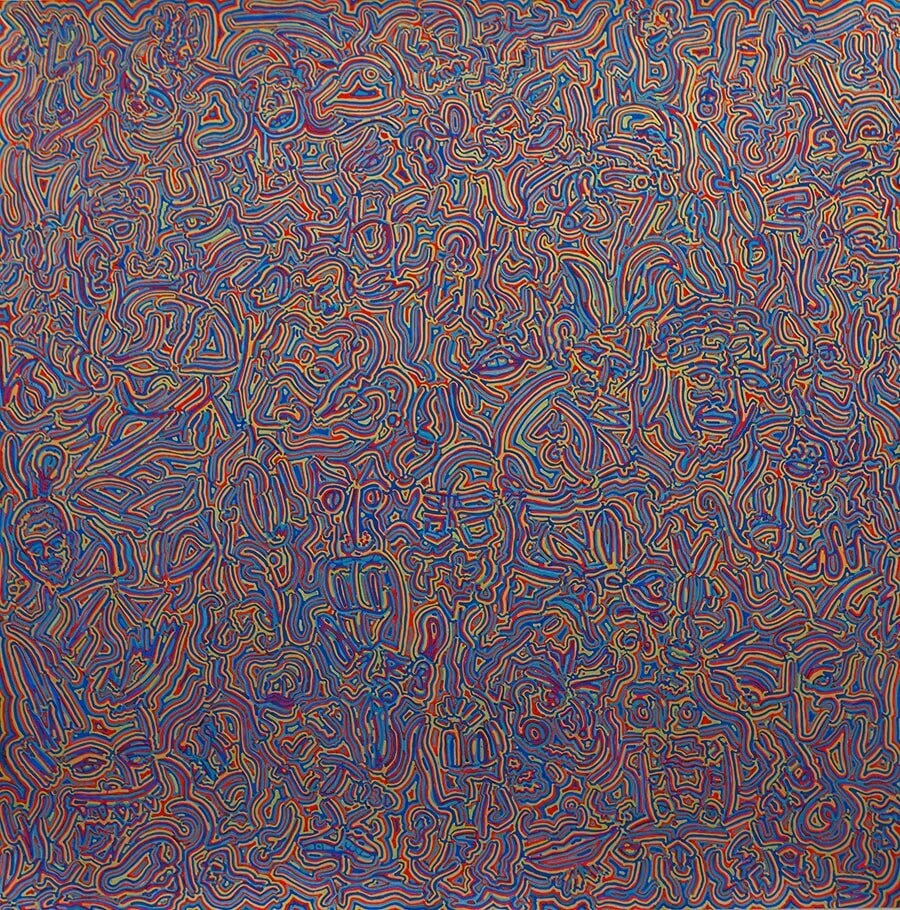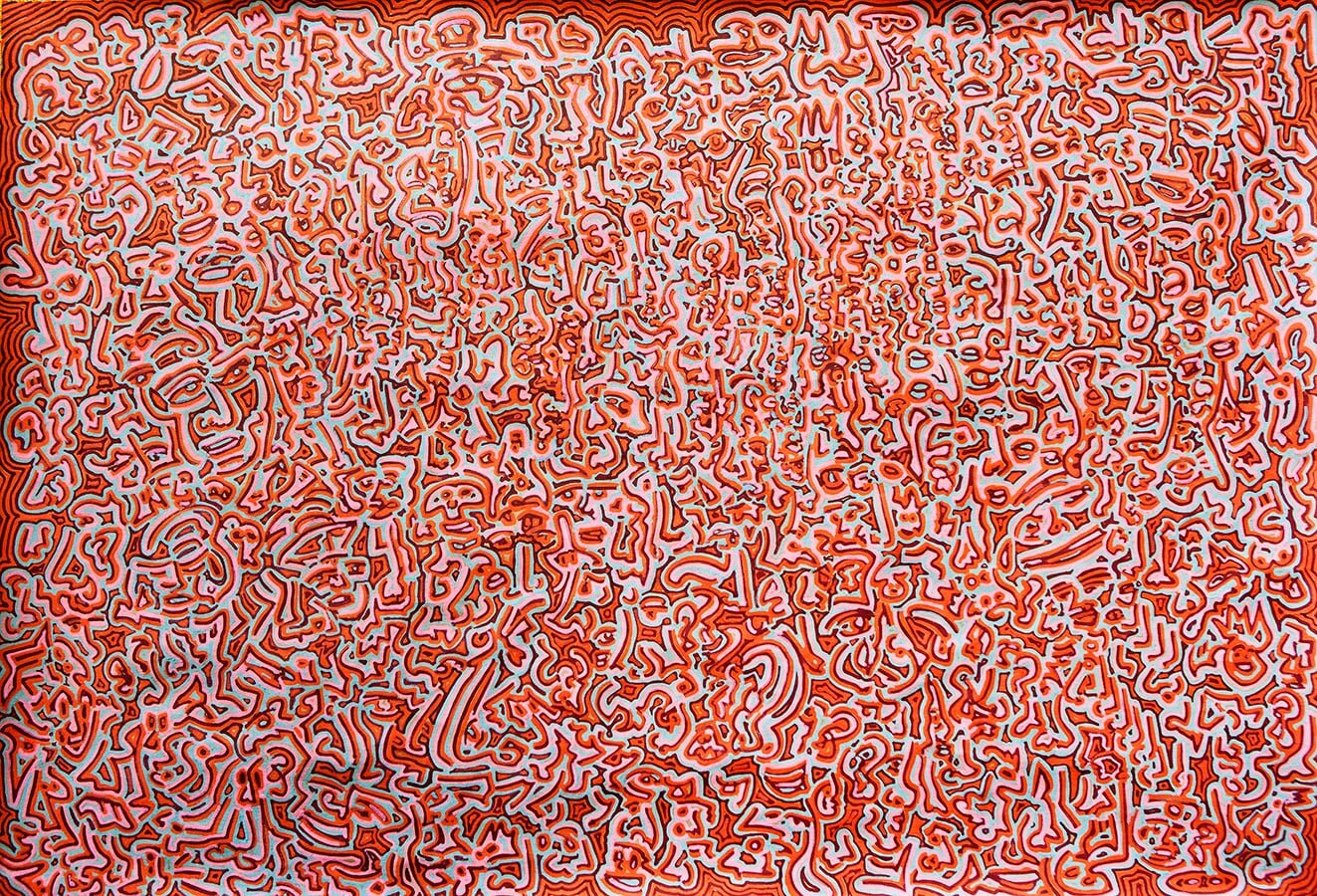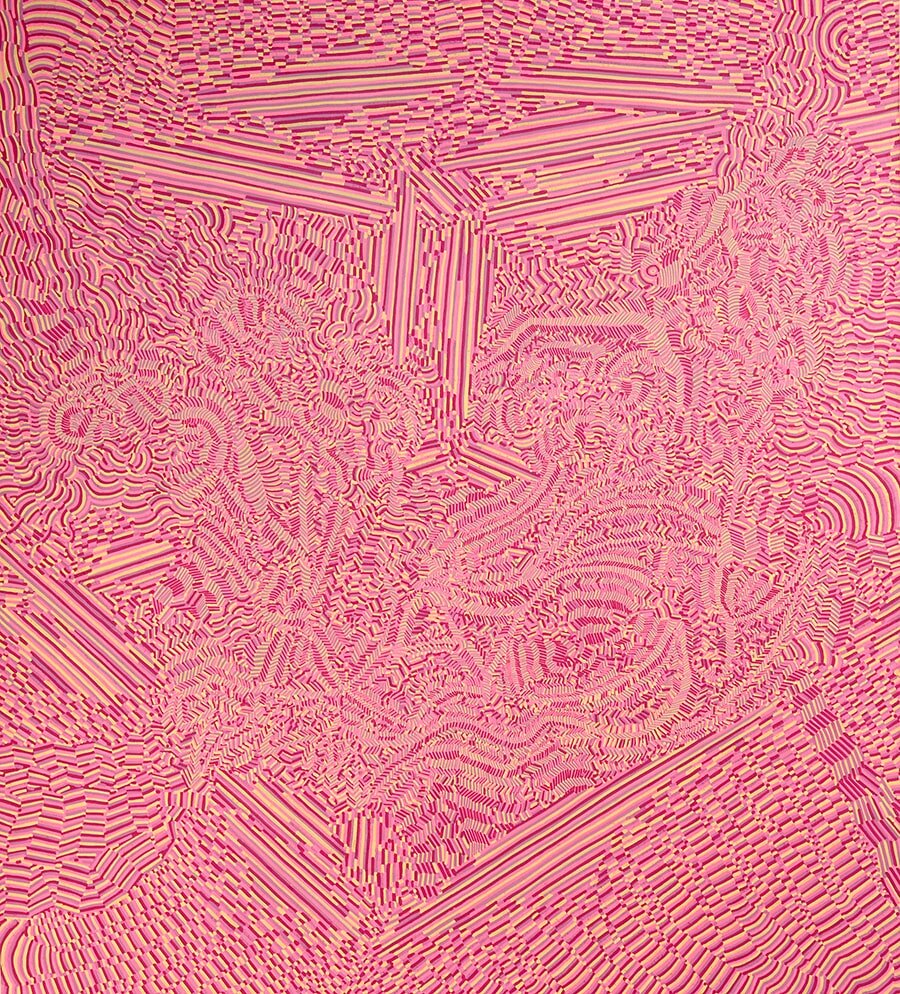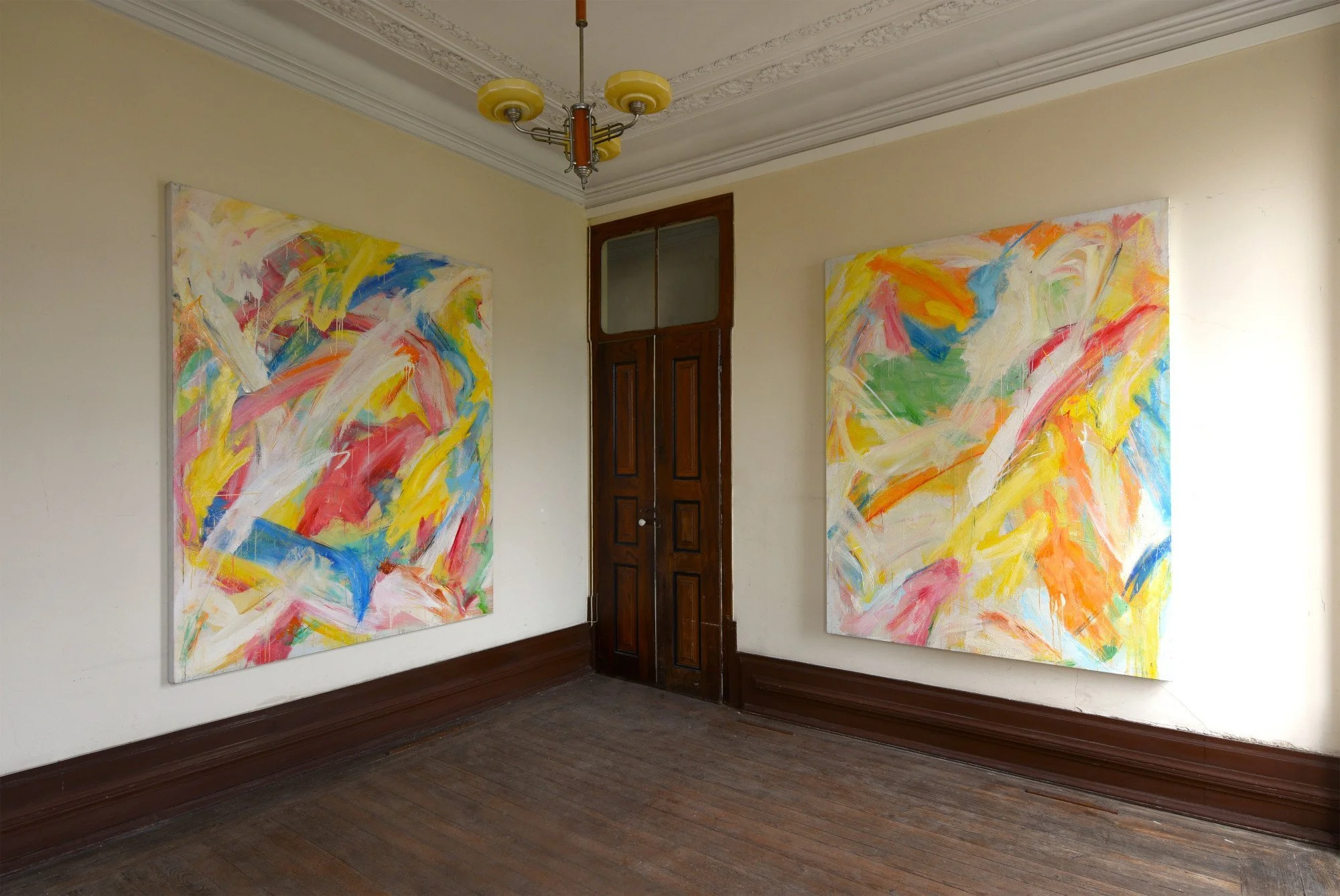10 Questions with Fernando Madera Alvarado
Fernando Madera Alvarado (Mexico 1983) began his artistic career when his first illustration was published in the now-defunct BUTT Magazine in 2008, just before completing his BFA at Concordia University in Montreal. After university, his first solo exhibition took place in 2010 at the Dutch art gallery FWBK in Amsterdam.
His work is mostly composed of bidimensional surfaces: paper of all sorts, canvases, walls, or wood panels. For the last couple of years, his work has been focused on acrylic ink compositions. He also works with digital software to modify his ink sketches and compile them for use on larger compositions.
A prominent feature of his work is that it almost always starts from ideas drawn on location. He collects these ideas and translates them in his own pictorial language drawn from my own experience and the vernacular. He composes visual narratives.
Fernando Madera Alvarado is currently working on what he will present at the open studios at Lagos Estudios y Residencias para Artistas in Mexico City. He is in the middle of a 1-year residency, and we will hold the open studios parallel with the upcoming Art Week of Mexico City in February.
Fernando Madera Alvarado portrait
ARTIST STATEMENT
“Through my line work, I convey both my ideas and my own take on visual language. Although my academic background is Design Art, throughout the years, the work I have presented on art galleries is more consistent with abstract/figurative painting: Linework, honest impressions, and textures are its highlights.
I have an affinity with papers of all sorts but especially with Japanese papers. This has to do with their translucent properties and my appreciation of the artisanal process of making them. The choice of paper/surface that I make for my work complements its meaning. I live and work both in Mexico City and Valparaiso, Zacatecas. Mexico.”
- Fernando Madera
Untitled Crisis, Dibond print, 220x120 cm, 2013 © Fernando Madera Alvarado
Get your limited edition copy now
INTERVIEW
Could you tell us a little more about your background? Why are you an artist, and when did you first become one?
I was born in Mexico City, but at 16 years old, my family sent me to Montreal, where I completed my High School diploma and later attended Dawson college in the Creative Arts and Literature Pre-University program. After that, I applied to the Design Art Department of the Faculty of Fine Arts at Concordia University for the BFA. After University, I lived for six years in the Netherlands, where I started my career as a visual artist.
The first time that I strongly felt that my drawings mattered was when one of them got published in the pink pages of the now-defunct BUTT magazine in 2008 (issue 21 p.79). Growing up as an international student, I struggled with my identity and a sense of belonging. I remember having an urgency to belong or identify myself with a community or collective of creatives with shared interests and world views. I gravitated towards the content of this publication because it dealt with art, counterculture, and dissident bodies and identities at a time when these themes and imagery were so little portrayed in the media. This happened before social media platforms existed and printed media was very influential. I strongly remember this magazine's impact on me as a Design student because of its layout, aesthetic, and content. When I saw that one of my drawings from my second summer course at Parsons was published, I felt that my work could reach important audiences. Since then, I have gained more confidence in my own imagery to keep on further.
My first solo show was in 2010 at the Dutch art gallery FWBK in Amsterdam. That summer, gallery owner Frederick Willems trusted that I was ready to show my work at his space. I remember him most dearly because despite not speaking Dutch fluently at the time, he took me in and taught me so much about professionalism and artistic integrity. He taught me a lot about the ins and outs of Amsterdam and the art galleries but also about his experience as a painter and gallery owner. I remember when I first met him with my portfolio in hand, I asked him for an opportunity to show my work at his gallery, and he said no more than one time. I kept making my way to the Zwanenburgwal with new work every time until he felt that I was ready. This process of development, his patience, and his advice are my best memories of that time. From him, I learned an appreciation for true abstraction in painting, drawing, and sculpture.
Impertinencia, Acrylic ink on paper, 100x110 cm, 2019 © Fernando Madera Alvarado
What is your personal aim as an artist?
My personal aim is to continue growing as a visual artist and develop series of works to the best of my ability. I want to strengthen my relationships with the galleries that I currently work with, and I want our artists' collective to evolve.
I think that in my paintings, the creative process arises from the need to express the self and to communicate. I feel that I develop my own identity the more work I do. My ideas and emotions are externalized in compositions, almost as if it was an emotional need.
My work is personal, and I believe that in representation every small detail counts. I want to do my best to be aware of current world events in and outside the art world, and while conscious of these realities, I want to project my stance on my own terms in my work. My choice of theme, materials, and medium make my work complete. I also want to paint with a strong awareness of my connection to the land and the people of my surroundings wherever I might be.
How would you define yourself and your work? Which movements or schools would you compare your work to?
I define myself as an abstract/figurative painter, and I have been mostly associated with galleries dealing primarily with abstract art. Linework, honest impressions, and texture are the highlights of my compositions.
Besides the art galleries that I work within Mexico, I still send original artwork to Galerie Mooi Man in the city of Groningen in the Netherlands. They are one of the very few galleries around the globe specialized in male art. They produce a yearly artist calendar with work of their international network of artists with great success, and mine has appeared there for some years now. My submission for next year's edition is already sent.
I cannot deny that I used to paint and draw more male-centered art after art school, but as the years passed, I decided not to work specifically on those themes unless I wanted to do it purposely. Nevertheless, in my new acrylic compositions and ink drawings, male motifs sometimes surface organically, and I feel contempt. Regarding specific movements, I've always been fond of impressionism and abstract expressionism. I also like the current ramifications of abstraction and artwork dealing with the state of painting in Mexico these days.
I remember that for my first solo show, my work made the cover of the publication Art Alert Amsterdam and they described me with these words: He's one of the few young artists still working traditional mediums. Perhaps this description still applies, also for my sources of inspiration and outlook to produce artworks.
The Virtual is The Thinking, Acrylic ink on paper, 100x110 cm, 2020 © Fernando Madera Alvarado
De Danser, Acrylic ink on paper, 100x110 cm, 2019 © Fernando Madera Alvarado
In your work, you use different types of paper, but you are particularly fond of Japanese paper. Tell us more about it; what makes it so special? And how do its properties influence your work?
I've always been fond of paper as a medium, and I love its practicality to be transported easily since I am working at different locations constantly. Now, Japanese paper is undoubted of the finest quality, and its fabrication process is an art form. I strongly admire the artisanal process of making it, and when I get to work with it as a surface, I am extra careful. Japanese papers lend themselves to work with refined mediums like French fountain pen inks or brush pens and Indian ink. For my most elaborate works, I have used Japanese paper scrolls. I like their translucent qualities and the natural hues in which they come because I can use them in layers and create different meanings for compositions by superimposing their textures. I like how these papers have rough edges and imperfections that show in terms of mounting and presentation. When working with them, it is imperative to highlight the quality of their craftsmanship when mounting them for display.
Finally, small-scale works with delicate papers and materials allow me to work with special mounting systems for their display, like acrylic frames and magnets for support. I find it interesting how I can play with how my work is mounted and the dialogue these arrangements can create with the piece.
Where do you find inspiration?
I find inspiration in everyday life, just as in the work of other artists. Finding it happens for me naturally in the most unexpected situations or spaces. I like to keep up with current art events happening in the city, and I like to attend art fairs. Still, I am especially interested in independent artists' initiatives and gatherings. Like music, painting has a tempo, and in my case, its rhythm is directly related to my life trajectory.
© Fernando Madera Alvarado
In Montreal, I was inspired by the sketches I collected of people during my daily commute from the suburb to school and back. I made many of them in the metro, train, and bus because I spent so much time on them. Commuting was my time to sketch freely, and I remember pondering a lot about how I was collecting ideas from life outside school to develop them inside later. I derived larger works from my sketches with different mediums and surfaces like paper, canvas, or textile. From that time on, I became accustomed to carrying my sketchbook and gathering ideas and impressions anywhere.
I am also interested in virtual identities and representations of the self in the virtual. Quite a number of my compositions are derivatives of portraits. In this age of online networking, virtual representation has become paramount and accessible at everybody's fingertips. I find it interesting how app developers mediate this accessibility to connect with others, how to monetize user's data, and parallel to this, how much information people are willing to share and how.
What do you hope that the public takes away from your work?
I hope that the viewers do not just look at my works lightly and find them interesting instead. Hopefully, they see a memorable quality, and they read my compositions as works that can be revisited and re-interpreted. I hope for the audience to see versatility and potential.
Do you find that the shift to digital exhibitions and art fairs has helped you promote your work?
Before the pandemic, we had big gatherings at Galeria Vórtice openings, but now this is no longer possible. During these openings, we had lots of attendees, and the event functioned effectively. During our last group show running parallel with Zona Maco, the largest art fair in Mexico City, we did an in-live exhibition model in which we worked on our paintings at the gallery while people visited like an open studio. Visitors can come in, meet us and see how we work. This live model has yielded remarkable feedback because people are interested in who the artists are in person and how and with what tools they work.
In the gallery, we noticed that the general public asks at first hand for our social media contact due to the practicality for them to reach either the artist or gallery in a fast way. Inevitably, Instagram seems to be the platform of choice to showcase work because of its easy access. Regarding the shift to digital exhibitions, we noticed that in Mexico, at least, digital and physical gallery spaces go hand in hand. It is rare here for people to buy original artworks just by looking at them online. Buyers want to see the artwork in person before purchasing, so they might browse online, but they set up an appointment if they are to buy. Also, because now there are so many digital galleries and platforms to display artwork online, users get overwhelmed, so physical galleries act as a filter.
Dutch Puberality, Dibond print, 150x150 cm, 2013 © Fernando Madera Alvarado
Comunication under state, Acrylic ink on paper, 100x110 cm, 2021 © Fernando Madera Alvarado
What is one lesson you learned from this past year's experience? And how did it help you further develop your art?
I had to learn how to look closely at the other aspects of life outside of the world of art and how these could be represented in my visual narratives. Since the pandemic, so many people here have lost their jobs, and their lifestyles were shifted. Art galleries and museums were the first ones to close temporarily. In my case, It had no sense to stay in the big city during the lockdown, so I relocated back here up north, and I was lucky enough that I could integrate part-time in the family business here and continue painting.
Since I started living in Valparaiso full time, I have become more empathic and aware of the realities of Zacatecas and its dynamic. Unfortunately, the state of Zacatecas has had an ever-increasing level of insecurity and violence in the last couple of years due to drug cartel violence. Being here full time has allowed me to see first-hand how the local culture is intertwined with this reality of insecurity and how some locals deal with it. Mexico City is certainly not all of Mexico, but the disparities that make Mexican society so hierarchical are the same back there than here. Living within Mexico City's art bubble kept me unaware of how big and complex the insecurity situation is outside the capital city.
I am taking advantage of this time and location to dive into work. This small municipality has pushed me to not look at it as an obstacle but as an opportunity: Take advantage of the relaxed pace and quiet, breathe the clean air, and use the open space and natural landscape. I painted a landscape of the mountains in this area not long ago, and I haven't worked on that subject matter in years.
© Fernando Madera Alvarado
What are you working on now, and what are your plans for the future?
I am currently working on my third painting that I hope to bring and show at Galeria Vórtice for the coming event Gallery Weekend Mexico City in November. This event was pushed back for two months, but it will take place. Hopefully, by this upcoming event, health measures in the city will be more relaxed as vaccination roll out advances nationwide, and this will reflect on the number of attendants we will receive. I am aiming to assemble bigger and better bodies of work and extend my color palette. I will also continue my exploration of small-scale work because they too have a strong potential to carry a strong meaning and aesthetic value.
I wish for the times to return to somewhat the normality we all had before the pandemic so that art spaces can thrive again. I would like to keep participating in group shows and art fairs and accumulate more works for an eventual solo show.
And finally, tell our readers something they should know about you.
I am always reachable, so please feel free to contact me. I like to get feedback and to be in contact with people interested in my work.


























